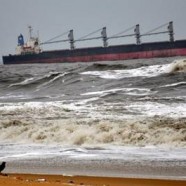The Seafarers Alcatraz Award 2012
The prestigious newspaper of the shipping world, the Lloyd’s List, has just attributed its awards for 2012. The “seafarer” award was attributed to the Costa Concordia’s crew.
The NGO, Robin des Bois (Robin Hood), based in Paris, would like to glorify the most dignified of the shipping community with a new prize that nobody would want to receive, the Alcatraz Award. The Seafarers Alcatraz Award could be attributed to a member of the shipping world, who, by its actions or lack of actions, inflicts upon seafarers, malnutrition, remoteness and exile. In 2012 it is attributed jointly to the port of Chennai in India and to South Korea for their leading parts in the sordid affair of the OSM Arena. Article 99 of the United Nations Convention on the Law of the Sea prohibits the transportation of slaves, however it does not prevent seafarers from being treated as slaves.
The Nisshin Maru: not to Catch but to Scrap
The Japanese government has announced that they are considering “major repairs” of the Nisshin Maru, the mother factory ship of the whaling fleet that works in Antarctica in the name of science. The work will be superficial because the Nisshin Maru should be ready in time for the departure to Antarctica which happens every year in November. The Japanese Fisheries Agency hopes that this fast cosmetic repair will resist 10 years.
However, the Nisshin Maru is old. She is fragile. She was launched in 1987.
Happy sailing in a toxic trail
MSC Flaminia
Press release # 9
PCB waste has burned in the fire following from the explosion of a container onboard MSC Flaminia on July 14th 2012 (see press release Robin De Bois, August 29, 2012). The fire raged for several days. The ship was then approximately 1800 km away from the English and French coasts. The burning of PCB generates dioxins that increased the overall toxicity of the emissions in the air and dispersed in the sea. (cf. introduction to the list of hazardous materials aboard MSC Flaminia). It is likely that the extinguishing waters inside the vessel contain PCB residues and dioxins mixed with other pollutants.
Hazardous Materials Onboard the MSC Flaminia
MSC Flaminia
Press Realease # 8
MSC Flaminia is a floating logistic warehouse. Its counterpart ground project would be subject to the Seveso Directive with strict regulation concerning construction and organizational requirements; such as fireproof walls, isolation distances between classes of hazardous materials, an internal organisation plan, a specific response plan including the intervention of external emergency resources. Fires in Seveso type plants on land requires the evacuation of people and the implementation of safety measures touching on the consumption of food produced in a perameter that can sometimes range quite far.
PCBs on board the MSC Flaminia
MSC Flaminia
Press release # 7
Update August 30, 9:45 am
The complete inventory of hazardous materials on board the MSC Flaminia has been made by an unofficial source. No radioactive material is declared. However, the big surprise is the presence of two PCB waste containers on board outside the damaged area. These PCBs are banned from production and use worldwide. They were undoubtedly intended for disposal in Europe. They came clearly the United States, since MSC Flaminia left Charleston. It is surprising that the United States would expose the marine environment to known high risks by transporting and exporting hazardous waste to Europe. Exportation from the United States to Europe is not illegal as long as done in accordance to the Basel Convention on transborder movements of hazardous waste. But it is illogical.
Is this nightmare going to end soon?
MSC Flaminia
Press release # 6 and chronology.
The MSC Flaminia’s wandering after its accident has lasted since July 14th, 2012. Until August 21, the containership in great distress, the tugs, and their crews were pushed away from French and British waters. The convoy remained in a no-man’s land, out of the range of helicopters in case of emergency. The lack of information about the kind of hazardous materials on board was a strenuous challenge to rescuers.
On July 18, after the second explosion, the first tug moved away about 2 km from the MSC Flaminia in order to avoid all risks. Simultaneously, MSC spoke of a “small explosion”.
MSC Flaminia : latest news
On August 26, MSC Flaminia was anchored off the Southwestern coast of England ; a team of experts boarded for inspection. They determined falling temperatures in the area destroyed by the fire and measured 50 degrees in hold 3 which has still been smouldering on August 23 ; this hold contains 245 containers among which 2 nitromethane boxes, now considered as no more endangered. There is no more open fire; the ship has now a list of 2.5 degrees.
The classification society of the ship confirms that the superstructure, the stern, the hull and the rudder are intact.
MSC Flaminia : to remove the doubts about radioactivity
MSC Flaminia
Press release no. 4
Inspection of the damaged container ship before she crosses the English Channel and the North Sea will take place in the coming days.
German experts along with British, Dutch and French specialists shall examine the condition of the vessel, her containers and her cargo.
Robin des Bois wishes this expertise to be completed by a radiological diagnosis of the ship. Hundreds of containers are damaged and the charterer of MSC Flaminia, Mediterranean Shipping Company (MSC), is known to occasionally transport radioactive materials. The company is also known for a lack of transparency when it comes to publishing, when required, an inventory of transported goods. In November 1997, the MSC Carla broke in two off the Azores during a journey from Le Havre to Boston. MSC have remained silent with regards to the nature of the cargo, and it was three days after the accident that the French Nuclear Installations Safety Directorate (DSIN) announced that three sealed radioactive sources for use in American hospitals were aboard MSC Carla; they sank with the fore section, whilst the aft section was towed to the Canary Islands.
The MSC Flaminia en route to Germany
MSC Flaminia
Press release no. 3
The MSC Flaminia could find refuge in Bremerhaven, Germany. Bremerhaven not only has docks avalaible for unloading MSC Flaminia, a process that will take several weeks, but also a dry dock for emergency repairs. The normal stopover time for a container ship of this size is a few hours. This remote destination requires the convoy to cross the English Channel and the North Sea. Germany is taking its responsibility as the MSC Flaminia flies the German flag. It is unfortunate that France, the United Kingdom and other countries closer to the current position of the MSC Flaminia were unable or unwilling to take charge of the ship.
Lead medal for the European Union
MSC Flaminia
Press release n° 2
The container ship MSC Flaminia that suffered an accident on 14th July 2012 is located 450 km to the west of Brest. She is carrying 2,876 containers and thousands of tonnes of propulsion fuel. The towing convoy is awaiting a possible destination other than the depths of the Atlantic. Will the records for wandering the high seas held by the Kharg V and the Castor be beaten?
The Kharg V, an Iranian oil tanker that fell into difficulties on 19th December 1989, had been refused entry to the waters of Morocco, Portugal, Spain, Senegal and Cape Verde. It was not until 6th February 1990 that transfer of the cargo on board Kharg V was completed, on the high seas off Sierra Leone, on to another Iranian tanker.











